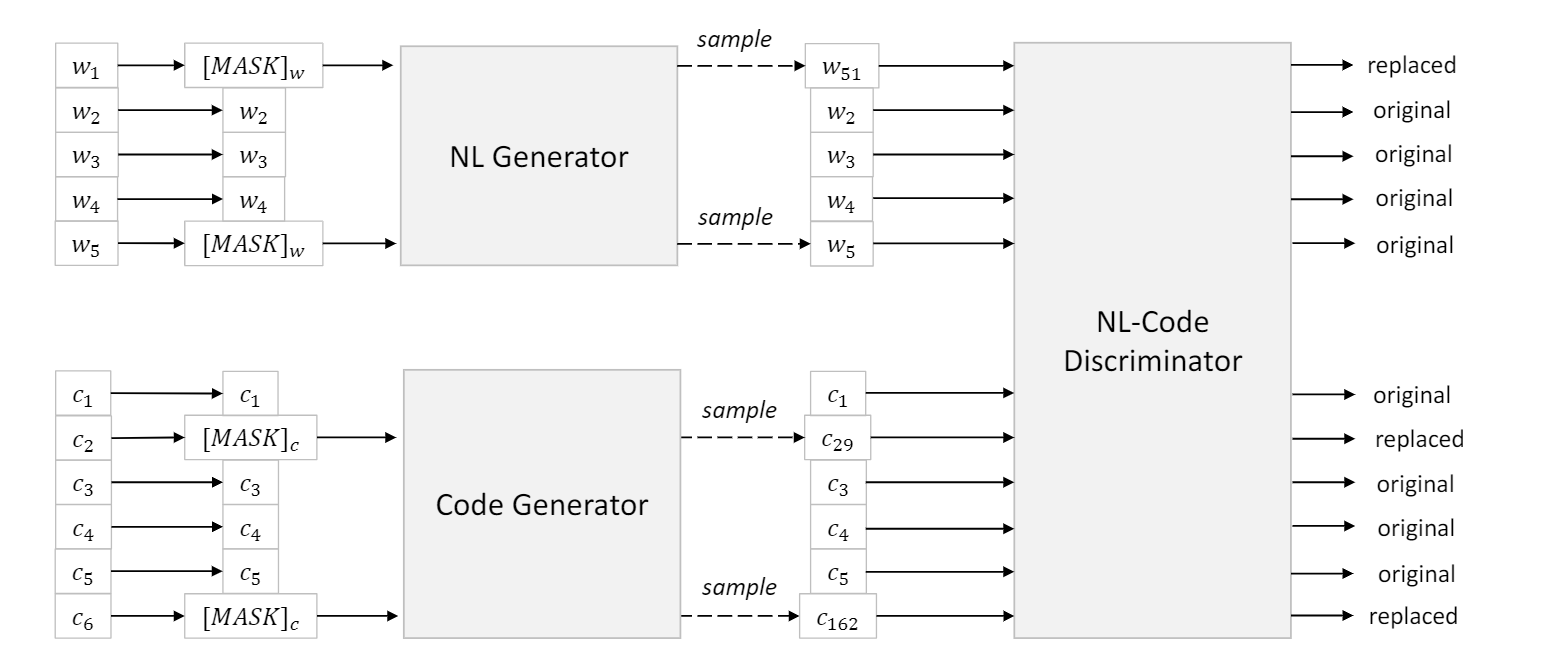-
CodeBERT理解
1.动机
大型的预训练模型,比如ELMo、GPT、Bert等提高了NLP任务的最新技术。这些预训练模型在NLP的成功驱动了多模态预训练模型,比如ViBERT、VideoBERT(他们从双模式数据,比如语言-图像对中进行自监督学习)
CodeBERT,是一种用于编程语言(PL)和自然语言(NL)的bimodal预训练模型。CodeBERT捕获自然语言和编程语言的语义连接,生成能广泛支持NL-PL理解任务(自然语言代码搜索)和生成任务(代码文档生成)的通用表示形式。
为了利用NL-PL pairs bimodal 实例和大量可用的uni-modal 代码,训练CodeBERT时用一个混合目标函数(包含标准掩码语言模型和 replaced token detection)
replaced token detection
在BERT中,句子内15%的token被选中,其中80%被[MASK]替换,10%被随机替换,10%保持不变,随后将替换后的句子输入到BERT中用于预测那些被替换的token。
论文作者认为BERT只学习这15%的token有点浪费算力,还存在[MASK]不会在实际任务中出现的问题。于是,文章提出了一个新的预训练任务:replaced token detection,即首先使用一个生成器预测句中被mask掉的token,接下来使用预测的token替代句中的[MASK]标记,然后使用一个判别器区分句中的每个token是原始的还是替换后的。

在预训练后,将判别器用于用于下游任务。作者认为replaced token detection任务让模型(判别器)可以在所有的token上学习,而不是那些仅仅被mask掉的token,这使得计算效率更高。2.1模型架构
遵循 BERT 和 RoBERTa ,并使用了多层双向 Transformer 作为 CodeBERT 的模型架构。通过使用与Roberta-Base完全相同的模型架构来开发Codebert。模型参数的总数为125M。
RoBERTa:
与BERT相比主要有以下几点改进:- 更大的模型参数量(论文提供的训练时间来看,模型使用 1024 块 V100 GPU 训练了 1 天的时间)
- 更大bacth size。RoBERTa 在训练过程中使用了更大的bacth size。尝试过从 256 到 8000 不等的bacth size。
- 更多的训练数据(包括:CC-NEWS 等在内的 160GB 纯文本。而最初的BERT使用16GB
BookCorpus数据集和英语维基百科进行训练)
另外,RoBERTa在训练方法上有以下改进:
- 去掉下一句预测(NSP)任务
- 动态掩码。BERT 依赖随机掩码和预测 token。原版的 BERT 实现在数据预处理期间执行一次掩码,得到一个静态掩码。 而 RoBERTa 使用了动态掩码:每次向模型输入一个序列时都会生成新的掩码模式。这样,在大量数据不断输入的过程中,模型会逐渐适应不同的掩码策略,学习不同的语言表征。
- 文本编码。Byte-Pair Encoding(BPE)是字符级和词级别表征的混合,支持处理自然语言语料库中的众多常见词汇。原版的 BERT 实现使用字符级别的 BPE 词汇,大小为 30K,是在利用启发式分词规则对输入进行预处理之后学得的。Facebook 研究者没有采用这种方式,而是考虑用更大的 byte 级别 BPE 词汇表来训练 BERT,这一词汇表包含 50K 的 subword 单元,且没有对输入作任何额外的预处理或分词。
2.2输入/输出表示
在预训练阶段,将输入设置为两个序列与特殊token的串联 [ C L S ] , w 1 , w 1 , w 2 , . . . , w n , [ S E P ] , c 1 , c 2 , . . . , c m , [ E O S ] [CLS] ,w_{1},w_{1},w_{2},...,w_{n},[SEP],c_{1},c_{2},...,c_{m},[EOS] [CLS],w1,w1,w2,...,wn,[SEP],c1,c2,...,cm,[EOS],其中一个序列是自然语言文本,另一个是编程语言。 [ C L S ] [CLS] [CLS]是两个部分前面的特殊token,其最终隐藏代表被视为分类或排名的汇总序列表示形式。
按照transformers中处理文本的标准方式,将自然语言文本看作一系列单词,把它分为WordPiece。把一块代码视为一系列tokens。
输出包括:- 对于自然语言和代码的每个token的上下文向量表示
- [CLS]的表示,该表示充当汇总序列表示
2.3训练数据
训练CodeBERT模型并行使用单峰数据和双峰数据,双峰数据就是NL-PL对,单峰数据就是单一的自然语言文本,或者是单一的代码。
数据来自公开可用的开源非fork github存储库,并用一组约束和规则过滤。- 每个项目至少被另一个项目使用过
- 每个文档都被截断为第一段
- 少于三个token的文档被删除
- 少于三行的函数被删除
- 函数名带有test的函数被删除
2.4预训练CodeBERT
两个训练目标:
- 掩码语言模型(MLM),应用于NL-PL pairs的双峰数据
- 替换token检测(RTD),应用于单峰数据
MLM
给定NL-PL pair( X = w , c X = {w,c} X=w,c)的数据点作为输入,其中 w w w是NL单词的序列, c c c是PL tokens的序列,我们首先选择NL和PL的随机位置集要掩盖(分别为 m w m^{w} mw和 m c m^{c} mc),然后用特殊的[MASK] token替换所选位置。其中x中15%的token被mask掉。然后预测被mask掉的原始token。
RTD
在我们的情况下对其进行调整,并在训练中同时使用双峰和单峰数据。具体而言,有两个数据生成器,一个NL,一个PL,均用于为一组随机掩盖的位置生成合理的替代方案。
判别器被训练检测一个单词是否是原始的单词,这是一个二分类问题。值得注意的是,RTD适用于输入的每个位置,如果生成器生成的单词恰好是原来真实的单词,则标签为 real 而不是 fake

NL和Code生成器都是语言模型,它们基于周围的上下文环境生成了被掩盖位置的合理的token,NL-Code Discriminator是目标的预训练模型,该模型通过检测从NL和PL生成器采样的合理的可替代方案来训练。NL-Code 判别器用于在微调阶段产生通用的表示。NL和Code生成器在微调阶段被抛出。2.5微调CodeBERT
有不同的设置可以在下游NL-PL任务中使用Codebert。例如,在自然语言代码搜索中,我们将输入与预训练阶段相同,并使用[CLS]的表示来测量代码和自然语言查询之间的语义相关性,而在代码到文本中生成,我们使用编码 - 解码器框架,并使用Codebert初始化生成模型的编码器。
3源码分析
从头开始预训练RoBERTa模型的步骤:
- 利用Tokenizer对语料分词
- 配置RoBERTa模型
- 训练任务的代码
- 数据输入模型进行训练
3.1对语料进行分词——RobertaTokenizer
核心代码在
\transformers\models\roberta\tokenization_roberta.py3.2配置RoBERTa模型
核心代码在
\transformers\models\roberta\modeling_roberta.py。3.3训练任务的代码
MLM任务:
class RobertaLMHead(nn.Module): """Roberta Head for masked language modeling.""" def __init__(self, config): super().__init__() self.dense = nn.Linear(config.hidden_size, config.hidden_size) self.layer_norm = nn.LayerNorm(config.hidden_size, eps=config.layer_norm_eps) self.decoder = nn.Linear(config.hidden_size, config.vocab_size) self.bias = nn.Parameter(torch.zeros(config.vocab_size)) self.decoder.bias = self.bias def forward(self, features, **kwargs): x = self.dense(features) x = gelu(x) x = self.layer_norm(x) # project back to size of vocabulary with bias x = self.decoder(x) return x- 1
- 2
- 3
- 4
- 5
- 6
- 7
- 8
- 9
- 10
- 11
- 12
- 13
- 14
- 15
- 16
- 17
- 18
- 19
- 20
- 21
- 对输入的embedding进行线性变换、激活和层归一化
- 输出形状为[batch_size, seq_length, vocab_size],即预测每个句子每个词是什么类别的概率值
3.4数据输入模型进行训练
class RobertaForMaskedLM(RobertaPreTrainedModel): _keys_to_ignore_on_save = [r"lm_head.decoder.weight", r"lm_head.decoder.bias"] _keys_to_ignore_on_load_missing = [r"position_ids", r"lm_head.decoder.weight", r"lm_head.decoder.bias"] _keys_to_ignore_on_load_unexpected = [r"pooler"] def __init__(self, config): super().__init__(config) if config.is_decoder: logger.warning( "If you want to use `RobertaForMaskedLM` make sure `config.is_decoder=False` for " "bi-directional self-attention." ) self.roberta = RobertaModel(config, add_pooling_layer=False) self.lm_head = RobertaLMHead(config) # The LM head weights require special treatment only when they are tied with the word embeddings self.update_keys_to_ignore(config, ["lm_head.decoder.weight"]) # Initialize weights and apply final processing self.post_init() def get_output_embeddings(self): return self.lm_head.decoder def set_output_embeddings(self, new_embeddings): self.lm_head.decoder = new_embeddings @add_start_docstrings_to_model_forward(ROBERTA_INPUTS_DOCSTRING.format("batch_size, sequence_length")) @add_code_sample_docstrings( processor_class=_TOKENIZER_FOR_DOC, checkpoint=_CHECKPOINT_FOR_DOC, output_type=MaskedLMOutput, config_class=_CONFIG_FOR_DOC, mask="" , expected_output="' Paris'", expected_loss=0.1, ) def forward( self, input_ids: Optional[torch.LongTensor] = None, attention_mask: Optional[torch.FloatTensor] = None, token_type_ids: Optional[torch.LongTensor] = None, position_ids: Optional[torch.LongTensor] = None, head_mask: Optional[torch.FloatTensor] = None, inputs_embeds: Optional[torch.FloatTensor] = None, encoder_hidden_states: Optional[torch.FloatTensor] = None, encoder_attention_mask: Optional[torch.FloatTensor] = None, labels: Optional[torch.LongTensor] = None, output_attentions: Optional[bool] = None, output_hidden_states: Optional[bool] = None, return_dict: Optional[bool] = None, ) -> Union[Tuple[torch.Tensor], MaskedLMOutput]: r""" labels (`torch.LongTensor` of shape `(batch_size, sequence_length)`, *optional*): Labels for computing the masked language modeling loss. Indices should be in `[-100, 0, ..., config.vocab_size]` (see `input_ids` docstring) Tokens with indices set to `-100` are ignored (masked), the loss is only computed for the tokens with labels in `[0, ..., config.vocab_size]` kwargs (`Dict[str, any]`, optional, defaults to *{}*): Used to hide legacy arguments that have been deprecated. """ return_dict = return_dict if return_dict is not None else self.config.use_return_dict outputs = self.roberta( input_ids, attention_mask=attention_mask, token_type_ids=token_type_ids, position_ids=position_ids, head_mask=head_mask, inputs_embeds=inputs_embeds, encoder_hidden_states=encoder_hidden_states, encoder_attention_mask=encoder_attention_mask, output_attentions=output_attentions, output_hidden_states=output_hidden_states, return_dict=return_dict, ) sequence_output = outputs[0] prediction_scores = self.lm_head(sequence_output) masked_lm_loss = None if labels is not None: loss_fct = CrossEntropyLoss() masked_lm_loss = loss_fct(prediction_scores.view(-1, self.config.vocab_size), labels.view(-1)) if not return_dict: output = (prediction_scores,) + outputs[2:] return ((masked_lm_loss,) + output) if masked_lm_loss is not None else output return MaskedLMOutput( loss=masked_lm_loss, logits=prediction_scores, hidden_states=outputs.hidden_states, attentions=outputs.attentions, )- 1
- 2
- 3
- 4
- 5
- 6
- 7
- 8
- 9
- 10
- 11
- 12
- 13
- 14
- 15
- 16
- 17
- 18
- 19
- 20
- 21
- 22
- 23
- 24
- 25
- 26
- 27
- 28
- 29
- 30
- 31
- 32
- 33
- 34
- 35
- 36
- 37
- 38
- 39
- 40
- 41
- 42
- 43
- 44
- 45
- 46
- 47
- 48
- 49
- 50
- 51
- 52
- 53
- 54
- 55
- 56
- 57
- 58
- 59
- 60
- 61
- 62
- 63
- 64
- 65
- 66
- 67
- 68
- 69
- 70
- 71
- 72
- 73
- 74
- 75
- 76
- 77
- 78
- 79
- 80
- 81
- 82
- 83
- 84
- 85
- 86
- 87
- 88
- 89
- 90
- 91
- 92
- 93
- 94
- 95
-
相关阅读:
B2B销售工作怎么做?
机器学习中基本符号表示和常用术语
【前端面试必知】什么是虚拟DOM
杰理之复位源【篇】
如何高效解决 C++内存问题,Apache Doris 实践之路|技术解析
axios进阶——取消已经发出去的请求
状态空间方程的离散化
基于Java的厨艺交流平台设计与实现(源码+lw+部署文档+讲解等)
OpenGL之图形流水线中的光照计算、明暗处理
读书笔记:《浪潮之巅:上》
- 原文地址:https://blog.csdn.net/weixin_45259560/article/details/127748638
